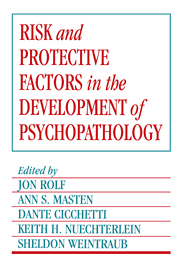Book contents
- Frontmatter
- Contents
- List of contributors
- Preface
- Part I Introduction: Historical and theoretical roots of developmental psychopathology
- Part II Contributions of the high-risk child paradigm: continuities and changes in adaptation during development
- 3 Early contributors to developmental risk
- 4 Beyond diathesis: toward an understanding of high-risk environments
- 5 Hard growing: children who survive
- 6 Children born at medical risk: factors affecting vulnerability and resilience
- 7 A mediational model for boys' depressed mood
- 8 A temperamental disposition to the state of uncertainty
- Part III Competence under adversity: individual and family differences in resilience
- Part IV The challenge of adolescence for developmental psychopathology
- Part V Factors in the development of schizophrenia and other severe psychopathology in late adolescence and adulthood
- A closing note: Reflections on the future
- Author index
- Subject index
6 - Children born at medical risk: factors affecting vulnerability and resilience
Published online by Cambridge University Press: 06 August 2010
- Frontmatter
- Contents
- List of contributors
- Preface
- Part I Introduction: Historical and theoretical roots of developmental psychopathology
- Part II Contributions of the high-risk child paradigm: continuities and changes in adaptation during development
- 3 Early contributors to developmental risk
- 4 Beyond diathesis: toward an understanding of high-risk environments
- 5 Hard growing: children who survive
- 6 Children born at medical risk: factors affecting vulnerability and resilience
- 7 A mediational model for boys' depressed mood
- 8 A temperamental disposition to the state of uncertainty
- Part III Competence under adversity: individual and family differences in resilience
- Part IV The challenge of adolescence for developmental psychopathology
- Part V Factors in the development of schizophrenia and other severe psychopathology in late adolescence and adulthood
- A closing note: Reflections on the future
- Author index
- Subject index
Summary
What happens to medically vulnerable infants when they return home? How likely are these infants to develop normally without neurological handicap, cognitive impairment, or problems in psychosocial development? The existing literature contains widely divergent estimates of later disability for these infants, ranging from 10% to 40% of a sample displaying adverse sequelae (Field, Sostek, Goldberg, & Shuman, 1979; Holmes, Nagy, & Pasternak, 1984; Kopp, 1983; Stewart, 1983). In part, differences in incidences of disabilities reflect the fact that the category of infants “medically at risk” is broad, encompassing many subgroups of infants with markedly differing biological and environmental problems. These infants may have experienced a variety of genetic, prenatal, perinatal, and/or postnatal risk events that are associated with an increased probability of problems in cognitive, social, affective, physical, and neurological arenas. The purpose of this chapter is to explore the multiple dimensions of medical risk conditions, focusing on the processes within or external to the child that exacerbate or attenuate risk status. The usefulness of a risk model as a conceptual and empirical framework for predicting later competence and adaptation is specifically examined for infants medically vulnerable because of the experience of chronic hypoxia and open heart surgery following birth with a congenital cyanotic heart defect.
During the last two decades, various innovative approaches to the study of high-risk, medically vulnerable infants have emerged. The work of investigators in these areas extends to children considered to be at risk as a result of either biomedical or environmental problems.
- Type
- Chapter
- Information
- Publisher: Cambridge University PressPrint publication year: 1990
- 5
- Cited by



